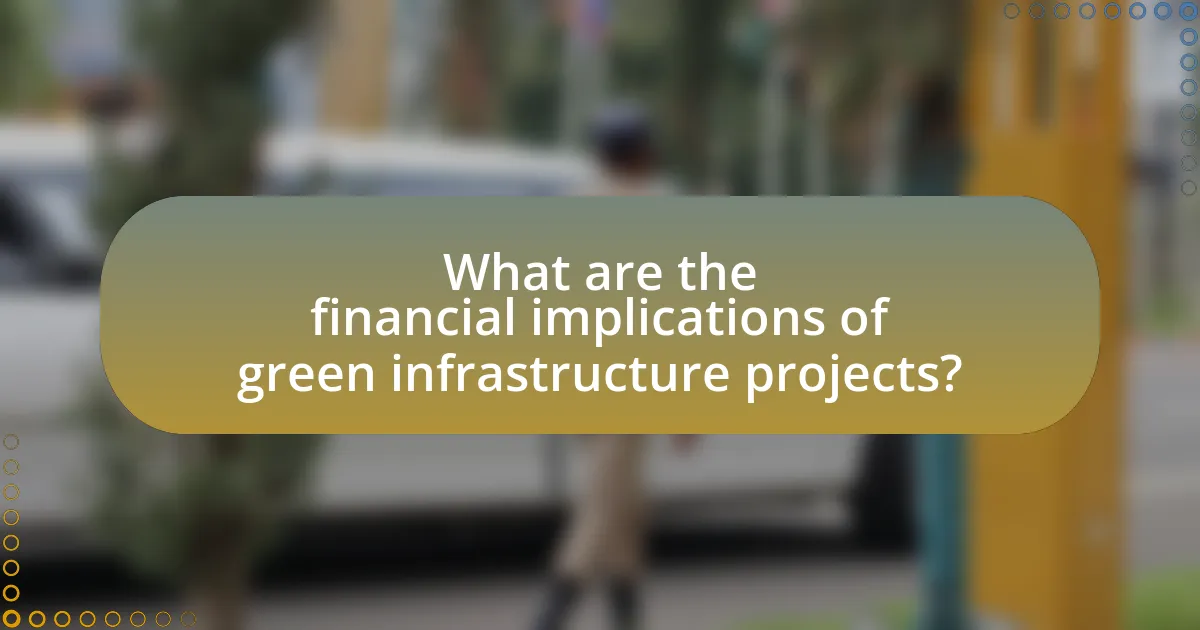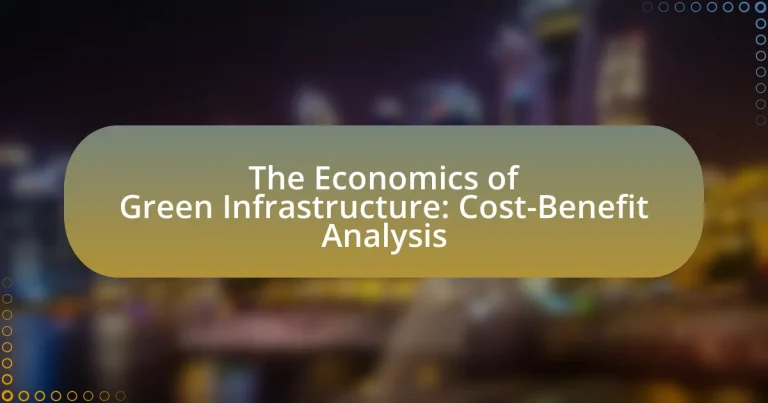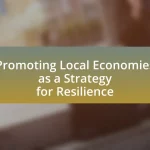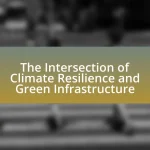The article focuses on the economics of green infrastructure, which involves the financial analysis and valuation of investments in natural systems that provide environmental benefits such as stormwater management, air quality improvement, and biodiversity enhancement. It highlights the cost-benefit analysis of green infrastructure projects, demonstrating their potential for long-term savings, increased property values, and improved public health. Key components of green infrastructure, including green roofs and permeable pavements, are discussed in relation to their economic viability and interactions that create value. The article also examines funding sources, government incentives, and the broader economic impacts of green infrastructure, emphasizing its role in enhancing local economies and promoting sustainability.

What is the Economics of Green Infrastructure?
The economics of green infrastructure refers to the financial analysis and valuation of investments in natural systems designed to provide environmental benefits, such as stormwater management, air quality improvement, and biodiversity enhancement. This approach quantifies the costs and benefits associated with green infrastructure projects, demonstrating their potential to yield long-term savings through reduced infrastructure costs, improved public health, and increased property values. For instance, a study by the American Society of Civil Engineers found that green infrastructure can reduce urban flooding costs by up to 50%, highlighting its economic viability.
How does green infrastructure contribute to economic sustainability?
Green infrastructure contributes to economic sustainability by enhancing ecosystem services that reduce costs associated with stormwater management, energy use, and urban heat. For instance, green roofs can lower energy consumption by providing insulation, which can reduce heating and cooling costs by up to 30%. Additionally, urban green spaces can increase property values, leading to higher tax revenues for municipalities. A study by the American Society of Landscape Architects found that every dollar invested in green infrastructure can yield up to $4 in benefits, demonstrating its economic viability.
What are the key components of green infrastructure?
The key components of green infrastructure include green roofs, permeable pavements, rain gardens, urban forests, and green walls. These elements work together to manage stormwater, reduce urban heat, improve air quality, and enhance biodiversity. For instance, green roofs can reduce building energy costs by providing insulation and decreasing the urban heat island effect, while permeable pavements allow for water infiltration, reducing runoff and flooding. Studies show that implementing green infrastructure can lead to significant cost savings in stormwater management and energy use, highlighting its economic benefits alongside environmental advantages.
How do these components interact to create economic value?
Green infrastructure components, such as vegetation, permeable surfaces, and water management systems, interact synergistically to create economic value by enhancing ecosystem services, reducing costs, and increasing property values. For instance, vegetation improves air quality and reduces urban heat, leading to lower energy costs for cooling. Permeable surfaces manage stormwater effectively, decreasing the need for expensive drainage systems and mitigating flood risks. Studies show that properties near green infrastructure can see a 7-15% increase in value due to aesthetic appeal and improved environmental conditions. These interactions collectively contribute to a more sustainable urban environment, resulting in long-term economic benefits.
Why is cost-benefit analysis important in evaluating green infrastructure?
Cost-benefit analysis is important in evaluating green infrastructure because it quantifies the economic value of environmental benefits against the costs of implementation. This analytical approach enables decision-makers to assess the financial feasibility and effectiveness of green infrastructure projects, such as urban parks or green roofs, by providing a clear comparison of expected benefits—like improved air quality, reduced flooding, and enhanced biodiversity—against the initial and ongoing costs. For instance, a study by the National Oceanic and Atmospheric Administration found that every dollar invested in green infrastructure can yield up to four dollars in economic benefits, demonstrating the significant return on investment. Thus, cost-benefit analysis serves as a critical tool for justifying investments in sustainable practices and guiding resource allocation in urban planning.
What methodologies are used in cost-benefit analysis?
Cost-benefit analysis employs several methodologies, including quantitative analysis, qualitative analysis, and multi-criteria analysis. Quantitative analysis involves assigning monetary values to costs and benefits, allowing for direct comparison; this often includes techniques such as net present value (NPV) and internal rate of return (IRR). Qualitative analysis assesses non-monetary factors, such as social and environmental impacts, which may not be easily quantifiable but are crucial for comprehensive evaluation. Multi-criteria analysis integrates both quantitative and qualitative data, enabling decision-makers to consider various factors beyond mere financial metrics. These methodologies collectively enhance the robustness and applicability of cost-benefit analysis in evaluating green infrastructure projects.
How do we quantify the benefits of green infrastructure?
To quantify the benefits of green infrastructure, researchers utilize various metrics such as cost savings from stormwater management, increased property values, and improved public health outcomes. For instance, a study by the American Society of Civil Engineers found that green roofs can reduce energy costs by up to 75% and stormwater runoff by 50%, demonstrating significant economic advantages. Additionally, the National Oceanic and Atmospheric Administration reported that urban green spaces can increase property values by 10-20%, further illustrating the financial benefits of green infrastructure. These quantifiable metrics provide a comprehensive understanding of the economic impact of green infrastructure initiatives.

What are the financial implications of green infrastructure projects?
Green infrastructure projects have significant financial implications, primarily through cost savings, increased property values, and enhanced economic resilience. These projects often lead to reduced stormwater management costs, as green roofs and permeable pavements can decrease the need for expensive drainage systems. For instance, a study by the American Society of Civil Engineers found that green infrastructure can save municipalities up to $3.2 billion annually in stormwater management costs. Additionally, properties near green infrastructure tend to see an increase in value; a report from the National Association of Realtors indicates that homes near parks and green spaces can sell for 20% more than similar homes without such amenities. Furthermore, green infrastructure contributes to economic resilience by mitigating the impacts of climate change, which can lead to lower disaster recovery costs and reduced insurance premiums. Overall, the financial benefits of green infrastructure projects are substantial and multifaceted, impacting municipal budgets, property markets, and long-term economic stability.
How do initial costs compare to long-term savings?
Initial costs of green infrastructure projects are typically higher than traditional infrastructure investments, but they lead to significant long-term savings. For example, a study by the National Academy of Sciences found that green roofs can reduce energy costs by up to 75% over their lifespan, offsetting the initial installation costs within a few years. Additionally, green infrastructure can lower stormwater management costs by reducing the need for extensive drainage systems, with some municipalities reporting savings of 30% to 50% in related expenses. Thus, while the upfront investment may be substantial, the long-term financial benefits and savings often outweigh these initial costs.
What factors influence the upfront investment in green infrastructure?
Upfront investment in green infrastructure is influenced by factors such as initial capital costs, availability of funding sources, regulatory frameworks, and perceived long-term benefits. Initial capital costs refer to the expenses required to design and implement green infrastructure projects, which can vary significantly based on project scale and complexity. Availability of funding sources, including government grants, private investments, and public-private partnerships, plays a crucial role in determining the financial feasibility of these projects. Regulatory frameworks, including local, state, and federal policies, can either incentivize or hinder investment through tax credits, subsidies, or stringent environmental regulations. Lastly, perceived long-term benefits, such as reduced operational costs, enhanced property values, and improved public health outcomes, can motivate stakeholders to invest despite higher upfront costs. These factors collectively shape the decision-making process regarding investments in green infrastructure.
How can maintenance costs affect overall project viability?
Maintenance costs significantly impact overall project viability by influencing the long-term financial sustainability of the project. High maintenance costs can erode profit margins, making it difficult for projects to remain financially viable over time. For instance, a study by the National Academy of Sciences found that infrastructure projects with high ongoing maintenance requirements often face budget overruns, which can lead to project failure if not managed effectively. Additionally, if maintenance costs exceed initial projections, they can divert funds from other critical areas, further jeopardizing the project’s success. Therefore, understanding and accurately estimating maintenance costs is essential for ensuring the overall viability of any project, particularly in the context of green infrastructure, where long-term benefits must be balanced against ongoing expenses.
What funding sources are available for green infrastructure initiatives?
Funding sources for green infrastructure initiatives include federal grants, state and local government funding, private investments, and nonprofit organization support. Federal grants, such as those from the Environmental Protection Agency, provide financial assistance specifically for projects that enhance environmental quality. State and local governments often allocate budgetary resources for green infrastructure projects, reflecting their commitment to sustainability. Private investments can come from businesses seeking to improve their corporate social responsibility profiles or from impact investors focused on environmental outcomes. Nonprofit organizations also contribute funding through grants and partnerships aimed at promoting green infrastructure. These funding sources collectively support the development and implementation of green infrastructure initiatives, which are essential for sustainable urban development and environmental resilience.
How do public-private partnerships facilitate funding?
Public-private partnerships (PPPs) facilitate funding by leveraging the financial resources and expertise of both sectors to support infrastructure projects. These collaborations allow public entities to access private capital, reducing the burden on government budgets while enhancing project efficiency and innovation. For instance, in the United States, the Transportation Infrastructure Finance and Innovation Act (TIFIA) has enabled PPPs to secure over $30 billion in private investment for transportation projects, demonstrating the effectiveness of this funding model in addressing infrastructure needs.
What role do government incentives play in promoting green infrastructure?
Government incentives play a crucial role in promoting green infrastructure by providing financial support and reducing barriers for implementation. These incentives, such as tax credits, grants, and subsidies, encourage private investment in sustainable projects, making them more economically viable. For instance, the U.S. federal government offers the Investment Tax Credit (ITC) for solar energy systems, which has significantly increased solar installations across the country. According to the Solar Energy Industries Association, the U.S. solar market grew by 167% from 2010 to 2019, largely due to such incentives. Thus, government incentives effectively stimulate the growth of green infrastructure by enhancing financial feasibility and attracting investment.

What are the broader economic impacts of green infrastructure?
Green infrastructure has significant broader economic impacts, including increased property values, reduced infrastructure costs, and enhanced public health. Studies indicate that properties near green spaces can see value increases of 5% to 20%, as green infrastructure improves aesthetic appeal and livability. Additionally, green infrastructure can lower stormwater management costs by up to 50%, as it reduces the need for traditional gray infrastructure. Furthermore, improved air quality and reduced urban heat islands contribute to better public health outcomes, which can lead to decreased healthcare costs and increased productivity. For instance, the American Society of Civil Engineers estimates that investing in green infrastructure can yield a return of $2 to $4 for every dollar spent, highlighting its economic viability.
How does green infrastructure affect local economies?
Green infrastructure positively affects local economies by enhancing property values, attracting businesses, and reducing costs associated with stormwater management. Studies indicate that properties near green spaces can see value increases of 5% to 20%, as evidenced by research from the National Association of Realtors, which highlights the demand for homes in greener neighborhoods. Additionally, cities that invest in green infrastructure often experience lower infrastructure maintenance costs and improved public health outcomes, leading to reduced healthcare expenses and increased productivity. For instance, a report by the American Society of Civil Engineers found that green infrastructure can save municipalities up to $3.2 billion annually in stormwater management costs.
What job creation opportunities arise from green infrastructure projects?
Green infrastructure projects create job opportunities in various sectors, including construction, maintenance, and environmental management. These projects often require skilled labor for the installation of green roofs, permeable pavements, and urban forestry initiatives, leading to increased demand for construction workers, landscape architects, and environmental engineers. For instance, a report by the American Society of Civil Engineers indicates that investing in green infrastructure can generate approximately 1.5 million jobs in the United States by 2030, highlighting the significant employment potential associated with these initiatives. Additionally, ongoing maintenance of green infrastructure, such as parks and green spaces, creates long-term employment opportunities in community services and environmental stewardship roles.
How does green infrastructure enhance property values?
Green infrastructure enhances property values by improving aesthetic appeal, increasing environmental quality, and providing recreational opportunities. Properties located near parks, green roofs, and urban gardens often see a rise in market value due to the desirability of green spaces. A study by the National Association of Realtors found that homes with access to green spaces can sell for 5% to 20% more than similar homes without such access. Additionally, green infrastructure can lead to reduced stormwater management costs and lower energy expenses, further increasing property attractiveness and value.
What environmental benefits contribute to economic advantages?
Environmental benefits such as improved air quality, enhanced biodiversity, and effective stormwater management contribute to economic advantages by reducing healthcare costs, increasing property values, and minimizing infrastructure expenses. Improved air quality leads to lower rates of respiratory diseases, which can save billions in healthcare expenditures; for instance, the American Lung Association estimates that reducing air pollution could save the U.S. economy over $1 trillion annually. Enhanced biodiversity supports ecosystem services that are vital for agriculture and tourism, driving economic growth in those sectors. Effective stormwater management reduces flooding risks and the associated costs of disaster recovery, with green infrastructure solutions like permeable pavements and green roofs proving to be more cost-effective than traditional methods. These examples illustrate how environmental benefits translate directly into economic gains.
How does green infrastructure improve public health and reduce costs?
Green infrastructure improves public health by enhancing air quality, reducing heat-related illnesses, and providing recreational spaces, while also reducing costs associated with healthcare and stormwater management. For instance, urban green spaces can lower air pollution levels by up to 30%, leading to fewer respiratory issues and related healthcare expenses. Additionally, green infrastructure, such as green roofs and permeable pavements, can mitigate urban heat islands, decreasing heat-related health risks and energy costs for cooling. Studies indicate that every dollar invested in green infrastructure can yield up to four dollars in health benefits and cost savings, demonstrating its effectiveness in promoting public health and economic efficiency.
What role does green infrastructure play in climate resilience?
Green infrastructure plays a critical role in enhancing climate resilience by mitigating the impacts of extreme weather events and improving ecosystem services. It achieves this through natural systems such as parks, green roofs, and permeable pavements that absorb rainwater, reduce urban heat, and enhance biodiversity. For instance, studies have shown that urban areas with extensive green infrastructure can reduce flooding by up to 30% during heavy rainfall events, demonstrating its effectiveness in managing stormwater. Additionally, green infrastructure contributes to carbon sequestration, helping to lower greenhouse gas emissions and combat climate change. This dual function of managing water and reducing emissions underscores its importance in building resilient communities against climate-related challenges.
What best practices should be followed in implementing green infrastructure?
Best practices for implementing green infrastructure include conducting thorough site assessments, engaging stakeholders, and integrating multi-functional designs. Site assessments ensure that the specific environmental conditions and community needs are understood, which is crucial for effective planning. Engaging stakeholders, including local communities and experts, fosters collaboration and ensures that the infrastructure meets diverse needs. Multi-functional designs, such as combining stormwater management with recreational spaces, maximize benefits and enhance cost-effectiveness. These practices are supported by studies indicating that well-planned green infrastructure can lead to significant economic savings, such as reduced flooding costs and improved public health outcomes.
How can stakeholders effectively collaborate on green infrastructure projects?
Stakeholders can effectively collaborate on green infrastructure projects by establishing clear communication channels, defining roles and responsibilities, and engaging in joint decision-making processes. Effective collaboration is facilitated through regular meetings, shared platforms for information exchange, and the use of collaborative tools that allow for real-time updates and feedback. Research indicates that projects with strong stakeholder engagement, such as the Green Infrastructure for Resilient Urban Development project, demonstrate improved outcomes and cost efficiencies, highlighting the importance of collective input in planning and implementation phases.
What metrics should be used to evaluate the success of green infrastructure initiatives?
Metrics to evaluate the success of green infrastructure initiatives include stormwater management effectiveness, biodiversity enhancement, air quality improvement, and economic benefits. Stormwater management effectiveness can be measured by the reduction in runoff volume and pollutant loads, which are critical for assessing the infrastructure’s ability to mitigate flooding and improve water quality. Biodiversity enhancement can be quantified through species richness and habitat quality assessments, indicating the initiative’s impact on local ecosystems. Air quality improvement metrics involve measuring reductions in pollutants such as particulate matter and nitrogen dioxide, which directly correlate with public health benefits. Economic benefits can be evaluated through cost savings in stormwater management, increased property values, and job creation associated with green infrastructure projects. These metrics provide a comprehensive framework for assessing the multifaceted impacts of green infrastructure initiatives.


